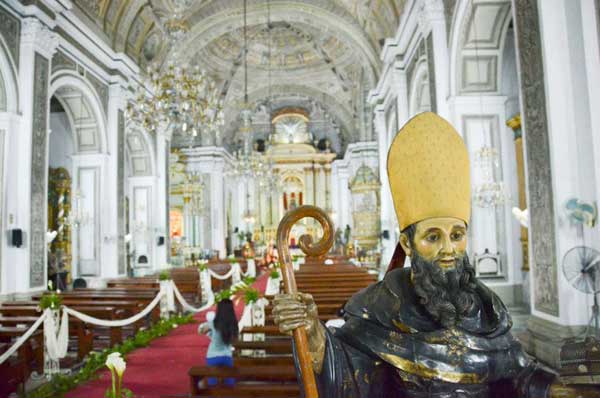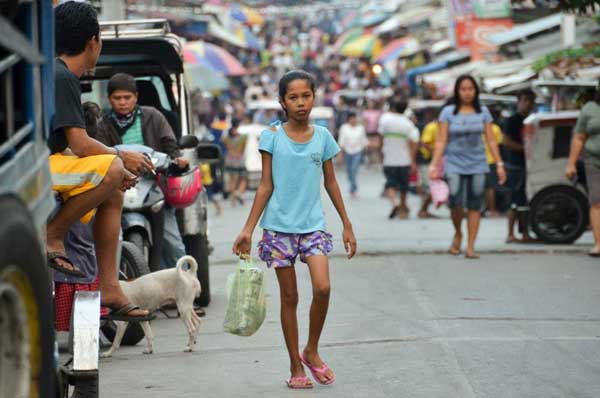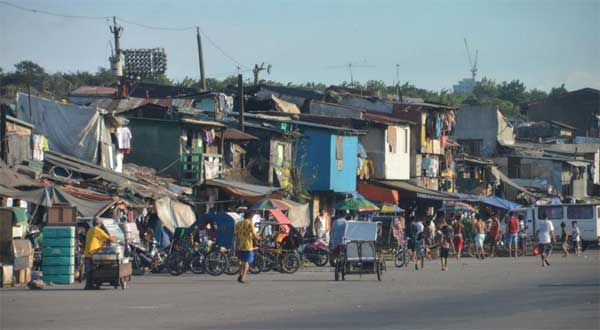The dogs bark, but the caravan moves on. Pope Francis has paid a spectacular visit to the Philippines. The welcome extended to him was amazing – at least six million people attended an open-air mass in Metro Manila after large crowds greeted him in Tacloban, the typhoon-ravaged city which was virtually destroyed at the end of 2013.
Cardinal Archbishop Luis Antonio Tagle called the visit a miracle. Yet the popular enthusiasm served to conceal deep fissures within the church itself. Even the CNN coverage, while enthusing inanely about glad-handing and baby hugging (while getting many factual details wrong), pointed out the crippling social legacy of a Catholicism still struggling to shed dark vestiges of the Spanish Inquisition.
The cruelty towards women and families of its stand against birth control and divorce was emphasized, the announcer struggling bravely to explain the cultural gap which divides the Philippines from the rest of the world.
The Pope has been active on the world stage of late, but this venture was part of a separate agenda, the shoring up of the Church in a place where many people are unconvinced by its teachings and religious observance is in decline. While 80 per cent of Filipinos profess the Catholic faith, there is a drift away from attendance at mass as society becomes increasingly youthful and secular.
In the event, Pope Francis made a surprisingly private visit. People were invited to line the route of his motorcade, which they did in droves, and there were the large open-air ceremonies in Manila and Tacloban as well. But the pontiff was only in the country for four days and his other functions were closed to the public.
He appears to have been conveying a message to various factions and sectors, including the Aquino2 administration itself. Given the body language of many dignitaries at the official welcome, behind-the-scenes exchanges must have been very lively indeed. And Aquino’s remark about troublesome priests, apart from being outrageous, won’t get him into heaven.
Whatever else, the Church in the Philippines is in disarray. The faith of the vast majority of Filipinos is, according to activist Irish priest Shay Cullen, “a version of Catholicism that is at variance many times with the gospel message of compassion, respect and self-sacrificing service to the poor and downtrodden”.

Fr Cullen himself has often been threatened by military death squads in his long fight against corruption in high places. His particular concern is the abuse of children and he clearly hoped that the Pope would address such issues. But the papal message was muted, at best.
Two incidents highlight the predicament of the church and reveal something of its involvement in the national crisis. The first of these is the case of Carlos Celdran, a tour guide, cartoonist, and social activist who is being hounded by the Church hierarchy after disrupting a service in the Manila cathedral.
On September 30, 2010, he marched down the aisle to the altar, calling out “stop getting involved in politics” and displaying a banner protesting the Church’s opposition to the Reproductive Health Bill, an attempt to introduce some watered-down reforms regarding family planning and women’s welfare.
He accused current clergy of being like Father Damaso, the clerical villain in a 19th century novel by the national hero Dr Jose Rizal. His writings got Rizal shot by the Spanish in 1896 (the Pope’s mass was held on the site of the execution and in the shadow of his memorial).
Celdran’s antics landed him in a tonne of trouble with the same Church, with the backing of the civil authorities, but with a less punitive result. The influential Catholic Bishops Conference of the Philippines (CBCP) charged him with “offending religious feelings”. He was found guilty early in 2013 and given an indeterminate sentence of up to a year in prison.
Carlos Conde of Human Rights Watch declared: “Nobody should be jailed for voicing an opinion or position, especially on a subject that concerns the lives of millions of Filipino women”.
More recently, the Court of Appeals upheld Celdran’s conviction after coming under tremendous pressure from local inquisitor Monsignor Nestor Cerbo, and the CBCP itself. Church spokesmen have denied conducting a witch-hunt, but Celdran is a leading advocate of progressive change and a prime candidate for clerical wrath.
Celdran made a nuisance of himself, but what transpired was no more than a failure of security within the cathedral precinct, a matter for a caretaker or hired guard.
So why this fuss? Clearly powerful elements within the local hierarchy will not tolerate a challenge to their authority, especially when it is disrespectful and uses ridicule as a weapon to make its point. Yet freedom of speech is a fundamental issue in a society enduring military oppression and an endless string of gross human rights violations. Pope Francis himself had spoken about freedom of expression on the long flight from Sri Lanka to the Philippines.
The second incident involves the murder of Italian missionary priest Fr Fausto “Pops” Tentorio. He was killed on October 17, 2011, by elements of the Armed Forces of the Philippines (AFP) in central Mindanao. This southernmost island group has been wracked by conflict for centuries and is presently exploring a new peace initiative with the bangsamoro (Muslim) communities.
Fr Pops, as he was widely known, worked among the indigenous peoples of Cotabato, a region of vast natural wealth and grinding poverty. He opposed the incursions of Australian mining companies and other foreign interests into tribal lands, the reason he was hounded by right-wing death squads and finally murdered.
Fr Pops was a member of the Pontifical Institute for Foreign Missions (PIME), an Italian missionary order directly responsible to the Pope. He was the parish priest in the Arakan Valley, probably the most militarized place in the world. He established dozens of schools, day care centres, and health clinics throughout the Cotabato region, infuriating the military and gravely endangering his own life.
Tentorio is the third PIME priest to be killed in Mindanao since the overthrow of Marcos. Pope Benedict XVI was furious on the occasion of his murder three years ago, and demanded a full inquiry. The Italian ambassador has remained on the case ever since. But the Manila regime has translated domestic impunity into international indifference by ignoring United Nations directives, the requests of foreign states, and dismissing initiatives to which the Philippines itself is a signatory.
President Aquino and Justice Secretary Leila de Lima recently turned their backs on a new inquiry into the murder of Fr Pops, disappointing local advocates like Fr Peter Geremia, a fellow PIME priest and survivor of numerous death threats himself.
Meanwhile, the Bagani Force, a militia unit established by the AFP and which is almost certainly guilty of the murder, continues to terrorize communities across a broad swathe of the Mindanao countryside.
The Philippines is in turmoil. Although few observers will say so, it has almost ceased to be a credible nation state. It functions on quasi-feudal patronage as amply demonstrated by the Catholic Church and its methods. Instead of showing the way, the Church has succumbed to the same problems afflicting other national institutions.

This reveals a failure of moral leadership and the lack of a reformist impulse. The Pope addressed similar circumstances when he was Archbishop of Buenos Aries and he must have experienced much déjà vu during his time in the Philippines (not for nothing did Imelda Marcos as First Lady during Martial Law ban the playing of the song “Don’t Cry for Me Argentina”)!
The papal visit was tangential to the systemic woes of this troubled archipelago. Francis drew attention to the stark reality of poverty and inequality, but the average tourist could easily do the same. What matters is where such commentaries are going, and, in this case, they may not be going anywhere.
Is he likely to offer much relief to his flock? On the flight back to Rome from the Philippines, and based on what he had seen there, the Pope said he didn’t expect people “to be like rabbits”, a statement of basic Church teaching told with a little compassion.
But is a little compassion enough? Much will depend upon what goes on behind the scenes in the Vatican in the months and even years ahead. If Pope Francis was well briefed and looked carefully at what he saw and listened intently to what was said to him, he might have gained some insight into the labyrinth of deceit and impunity which the Philippines has become in recent times.
This large conglomeration of the (almost) faithful includes inspiring clergy and lay teachers, and many dedicated and tireless champions of the poor and needy. But it also encompasses everything Pope Francis has announced himself to be against in his crusade to redeem the church.
Meanwhile the spectre of liberation theology (LT) still seems to haunt the archipelago.
An import from Latin America, where former Cardinal Bergoglio became caught between its idealism and the excesses of military dictatorship, it became prominent during the Martial Law years and immediately after the overthrow of Marcos.
Catholics for National Liberation (CNL) remains a member of the revolutionary National Democratic Front (NDF). But LT has been criticized for ignoring the special plight of women.
Filipinas are crying out for equity and justice on a range of issues from family planning and divorce to labor law reform and greater opportunities for women. And was the pope truly propounding some form of liberation theology behind the scenes during his visit? More likely that the rabidly conservative Philippine hierarchy will have construed something of this in his message – and begun preparing to resist such change at all costs.

The pontiff has been invited back to the Philippines to attend the 51st Eucharistic Congress in Cebu in January next year. If he ignores what he learned on this visit, there will be another million or so Filipinos waiting to greet him, poverty will be even worse, and the environment more damaged, whatever the spinmeisters of the Millennial Development Goals will attempt to prove.
And the Catholic Church will be even further from achieving relevance and moral leadership in this benighted archipelago.
Dr Peter M. Sales is an honorary fellow in the Faculty of Arts, Law and the Humanities at the University of Wollongong and spends much of his time researching in the southern Philippines.
Donate To New Matilda
New Matilda is a small, independent media outlet. We survive through reader contributions, and never losing a lawsuit. If you got something from this article, giving something back helps us to continue speaking truth to power. Every little bit counts.



